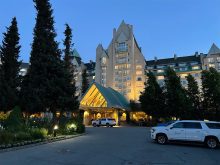She has been the toast of farmer gatherings and a guest at dozens of prairie farms. She has met with provincial and federal politicians and dignitaries. She has negotiated the icy mountain passes of British Columbia and driven across Canada in the middle of winter. She has been arrested twice.
Who is this intrepid gal?
None other than Prairie Belle, the Massey Ferguson 860 combine that became a symbol of farmer protest in 1998-2001. Now her owner, Nick Parsons, is seeking a home for the combine in a prairie museum. She has more than 7,300 hours on her, including about 700 on the road. And, according to Parsons, Belle also has her own library of videos, photos and press clippings.
Read Also

Downturn in grain farm economics threatens to be long term
We might look back at this fall as the turning point in grain farm economics — the point where making money became really difficult.
“I believe she’s certainly earned her spot in any museum,” says Parsons. “There’s probably not a farmer between here and Ottawa that doesn’t know the name Prairie Belle.”
Saskatchewan’s Western Development Museum has been approached as a potential home and Parsons is awaiting word. He thinks a spot in Saskatchewan, the heart of prairie agriculture, would be fitting.
Parsons has used the 1980 combine for every harvest since 1981, with the exception of this year. But Prairie Belle was also his vehicle of choice in January 1998 when he drove it from his farm in Farmington, B.C., to Victoria. He was protesting the province’s refusal to recognize Peace River country as a farming disaster area after two years of wet weather prevented harvest.
That trip saw him negotiate the roads through Cache Creek, Lillouet, Whistler and Squamish before riding the ferry to Nanaimo and driving to the B.C. legislature.
Parsons got little satisfaction from politicians, but that didn’t stop him from starting a trek to Ottawa in January 2001 to seek greater agricultural assistance for Canadian farmers. That journey took more than seven weeks.
Belle reached Sault St. Marie in a snowstorm, then pushed on to Queen’s Park in downtown Toronto, causing consternation among the constabulary.
Eventually Parsons and the combine reached Parliament Hill, participated in a rally and received a private audience with then-prime minister Jean Chretien.
“Whether I did any good or not, I do not know,” Parsons says today. “All I know is, I had a following to Ottawa. Prairie Belle had a following to Ottawa. And I know doing nothing does no good.”
The Western Development Museum gets many offers of artifacts for its collections, likely too many to accommodate. But surely Prairie Belle would be a valuable addition as a unique symbol of farmer protest. We hope she finds a home.
















